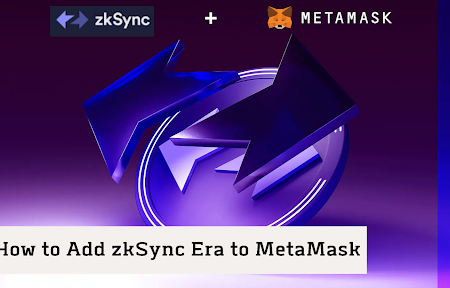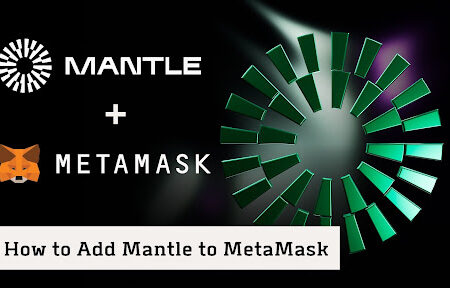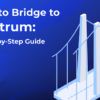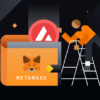The most widely used platform for dApps, smart contracts, and DeFi is Ethereum. But it also faces certain difficulties, like high costs, network congestion, and scalability restrictions.
Due to this, several projects are developing layer 2 solutions. One such project is Arbitrum, a rollup-based scaling solution that provides quick, inexpensive, and safe transactions. How to bridge ETH to Arbitrum and some of the advantages of utilizing Arbitrum are covered in this post.
What is Arbitrum?
To boost throughput, lower gas costs, and enhance user experience, Arbitrum leverages optimistic roll ups as a layer 2 scaling solution for Ethereum. Offchain Labs, a group of Princeton University academics and technologists, created Arbitrum.
Without sacrificing security or decentralization, Arbitrum seeks to increase the scalability and accessibility of Ethereum. Comparing Arbitrum to other layer 2 solutions, the following benefits are claimed:
- Compatibility: Arbitrum supports any Ethereum smart contract or dApp without requiring code changes or special tools. You can use your existing Ethereum wallets, tools, and libraries to interact with Arbitrum.
- Flexibility: Arbitrum allows developers to customize their rollup chains’ gas fees, block times, and consensus rules. This gives them more control and freedom over their applications.
- Security: Arbitrum inherits the security of Ethereum, as any invalid or fraudulent rollup block can be challenged and reverted on the Mainnet. Arbitrum also uses fraud and data availability proofs to ensure that all transactions are valid and available.
- User experience: Arbitrum offers fast confirmation times, low gas fees, and smooth cross-chain interoperability. Users can easily switch between the Mainnet and Arbitrum using the bridge interface.
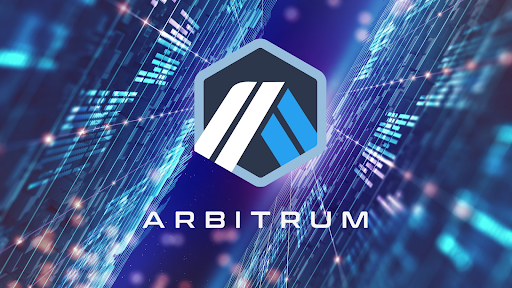
Arbitrum is a Layer 2 scaling solution
How does Arbitrum work?
Arbitrum creates a separate layer 2 network that runs on top of Ethereum. This network consists of three main components:
- Validators: These nodes run the Arbitrum virtual machine (AVM) and execute transactions on the rollup chain. Validators can be anyone who stakes ETH on the Mainnet to participate in the network.
- Sequencer: This is a special validator that collects transactions from users and orders them into a sequence. The sequencer then submits the series as a rollup block to the Mainnet. The sequencer acts as a coordinator and leader of the network, but it has no power or authority over other validators or users.
- Bridge: This smart contract connects the Mainnet and the rollup chain. The bridge allows users to deposit and withdraw their assets between the two networks. The bridge also acts as a dispute resolution mechanism that handles any challenges or disputes that arise on the rollup chain.
The basic workflow of Arbitrum is as follows:
- A user sends a transaction to the sequencer or a validator on the rollup chain.
- The sequencer or validator executes the transaction on the AVM and updates the state of the rollup chain.
- The sequencer batches multiple transactions into a single rollup block and submits it to the bridge contract on the Mainnet.
- The bridge contract assumes the rollup block is valid unless someone challenges it within a certain period (usually one week).
- If no one challenges the rollup block within the period, it becomes finalized and accepted by the bridge contract.
- If someone challenges the rollup block within the period, they must provide a bond in ETH and submit proof of invalidity or fraudulence to the bridge contract.
- The bridge contract then verifies the proof and determines whETHer the rollup block is valid or invalid.
- If the rollup block is valid, the challenger loses their bond, and the rollup partnership becomes finalized and accepted by the bridge contract.
- If the rollup block is invalid, the challenger receives their bond back, and the rollup block is reverted and rejected by the bridge contract.
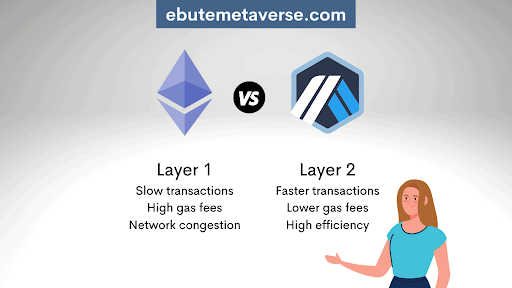
How does Arbitrum Works – To Arbitrum Ultimate Newbie Guide
How to Bridge ETH to Arbitrum?
To use Arbitrum, you must bridge your ETH from the Ethereum Mainnet to the Arbitrum network. This is because Arbitrum has its own token standard and address space, which differ from Ethereum’s.
Bridging ETH to Arbitrum allows you to interact with dApps and smart contracts on Arbitrum and transfer your ETH back to the Mainnet when you want to.
To bridge ETH to Arbitrum, you must use the official Arbitrum bridge interface, a web-based application that connects to your Ethereum wallet and allows you to deposit and withdraw your assets between the two networks.
Here are the steps to bridge ETH to Arbitrum using the bridge interface:
- Connect your Ethereum wallet to the bridge interface. You can use any Ethereum wallet that supports web3, such as MetaMask, Ledger, Trezor, or WalletConnect.
- Select the network you want to connect to. You can choose between Ethereum Mainnet and Arbitrum One. Arbitrum One is the Mainnet version of Arbitrum, which is live and open to everyone. There are also other Testnet versions of Arbitrum, such as Rinkeby and Ropsten, for testing and development purposes only.
- Choose the direction of the transfer. You can either deposit or withdraw your assets between the two networks. To bridge ETH to Arbitrum, you must deposit your ETH from the Mainnet to Arbitrum.
- Enter the amount of ETH you want to deposit. You can enter any amount of ETH in your wallet, but remember that there is a minimum deposit of 0.01 ETH and a maximum deposit of 100 ETH per transaction. You must also pay a gas fee on the Mainnet for the deposit transaction, which depends on the network congestion and demand.
- Confirm the deposit transaction. You will see a confirmation pop-up showing your deposit transaction details, such as the amount, gas fee, destination address, and transaction hash. You need to confirm the transaction on your wallet and wait for it to be processed on the Mainnet.
- Wait for the confirmation on Arbitrum. After your deposit transaction is approved on the Mainnet, it will take some time to reflect it on Arbitrum. This is because Arbitrum uses a delayed state update mechanism, meaning it takes about 10 minutes for a Mainnet transaction to be finalized and accepted by Arbitrum. By entering your transaction hash or destination address , you may see the status of your deposit transaction.
- Enjoy using Arbitrum. Once your deposit transaction is confirmed on Arbitrum, your ETH balance will be updated on the bridge interface. You can now use your ETH to interact with dApps and smart contracts on Arbitrum, such as Uniswap, SushiSwap, Aave, Balancer, Curve, MakerDAO, Compound, and more.
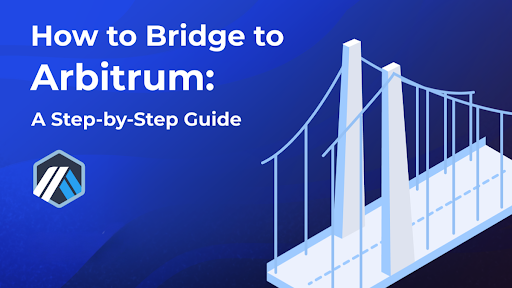
How to bridge ETH to Arbitrum?
How to Bridge ETH back to Mainnet?
To bridge ETH back to Mainnet or to use the Arb to ETH Bridge, you must follow a similar process as above, but in reverse. Here are the steps to Bridge ETH back to Mainnet using the bridge interface:
- Connect your Ethereum wallet to the bridge interface. You need to use the same wallet that you used to deposit your ETH from Mainnet to Arbitrum.
- Select the network you want to connect to. You must choose Arbitrum One as your source network and Ethereum Mainnet as your destination network.
- Choose the direction of the transfer. You need to withdraw your ETH from Arbitrum to Mainnet.
- Enter the amount of ETH you want to withdraw. You can enter any amount of ETH in your wallet, but remember that there is a minimum withdrawal amount of 0.002 ETH and a maximum withdrawal amount of 1000 ETH per transaction. You must also pay a gas fee on Arbitrum for the withdrawal transaction, which is much lower than on Mainnet.
- Confirm the withdrawal transaction. You will see a confirmation pop-up showing your withdrawal transaction details, such as the amount, gas fee, destination address, and transaction hash. You need to confirm the transaction on your wallet and wait for it to be processed on Arbitrum.
- Wait for the confirmation on Mainnet. After your withdrawal transaction is approved on Arbitrum, it will take some time to reflect it on Mainnet. This is because Arbitrum uses a delayed withdrawal mechanism, meaning it takes about one week for a withdrawal transaction to be finalized and accepted by Mainnet. You can check the status of your withdrawal transaction by entering your transaction hash or destination address.
- Receive your ETH on Mainnet. Once your withdrawal transaction is confirmed on Mainnet, your ETH balance will be updated in your wallet. You can now use your ETH to interact with dApps and smart contracts on Mainnet or transfer it to another wallet or exchange.
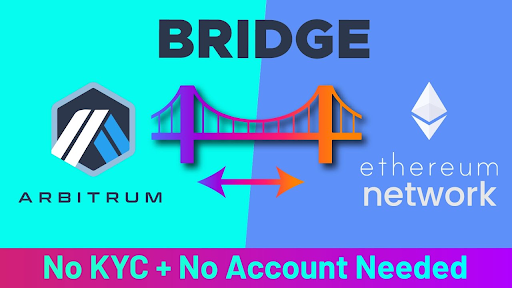
Arbitrum to Ethereum Bridge
Benefits and risks of using Arbitrum
| Pros of Arbitrum | Cons of Arbitrum |
| Faster and cheaper transactions: Arbitrum can process thousands of transactions per second, with confirmation times of about 10 minutes and gas fees of a few cents. | Delayed state updates: Arbitrum uses a delayed state update mechanism, meaning it takes about 10 minutes for a Mainnet transaction to be finalized and accepted by Arbitrum and about one week for a withdrawal transaction to be finished and accepted by Mainnet. |
| Compatibility and interoperability: Arbitrum supports any Ethereum smart contract or dApp without requiring code changes or special tools. You can use your existing Ethereum wallets, tools, and libraries to interact with Arbitrum. Using the bridge interface, you can also easily switch between the Mainnet and Arbitrum. | Potential bugs or attacks: Arbitrum is still a relatively new and experimental technology, which means it may have some bugs or vulnerabilities that could affect its functionality or security. For example, there could be a bug in the AVM that causes incorrect execution of transactions or an attack on the sequencer that causes network disruption or censorship. |
| Security and decentralization: Arbitrum inherits the security of Ethereum, as any invalid or fraudulent rollup block can be challenged and reverted on the Mainnet. Arbitrum also uses fraud and data availability proofs to ensure that all transactions are valid and available. Arbitrum is decentralized; anyone can become a validator by staking ETH on the Mainnet. | Limited liquidity and adoption: Arbitrum is still not widely adopted by users and developers, which means it may have limited liquidity and network effects compared to Ethereum or other layer 2 solutions. This could affect the user experience and the value proposition of Arbitrum. |
Conclusion
Optimistic rollups are used by Arbitrum, a layer 2 scaling solution, to boost throughput, save gas costs, and enhance user experience. Arbitrum supports Ethereum smart contracts or dApp without requiring code changes or special tools. Arbitrum also inherits the security and decentralization of Ethereum while offering faster and cheaper transactions. To use Arbitrum, you must bridge your ETH from the Ethereum Mainnet to the Arbitrum network using the official Arbitrum bridge interface, or the Arb bridge for short. You can then use your ETH to interact with dApps and smart contracts on Arbitrum. We hope this article has helped you understand how to bridge ETH to Arbitrum and how to use the Arbitrum to ETH bridge for Ethereum.
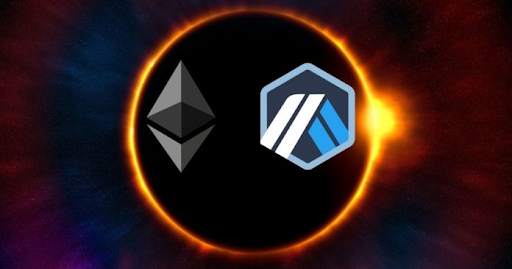
Arbitrum to ETH bridge for Ethereum
FAQs
How do I access dApps on Arbitrum?
To access dApps on Arbitrum, connect your Ethereum wallet to the Arbitrum network. You can do this by selecting the network option on your wallet and choosing “Arbitrum One” from the list of available networks.
If you don’t see this option, you may need to add it manually by following. Once you connect your wallet to the Arbitrum network, you can access any dApp that supports Arbitrum, such as Uniswap, SushiSwap, Aave, Balancer, Curve, MakerDAO, Compound, and more.
How do I become a validator on Arbitrum?
To become a validator on Arbitrum, you must stake ETH on the Mainnet and run the AVM software on your node. You can find more information on how to become a validator on this page, which explains the requirements, benefits, and risks of being a validator on Arbitrum.
How do I contact the Arbitrum team or community?
To contact the Arbitrum team or community, you can use any of the following channels:
- Website: https://offchainlabs.com/
- Twitter: https://twitter.com/OffchainLabs
- Discord: https://discord.gg/5KE54JwyTs
- Telegram: https://t.me/Arbitrumrollup
- Reddit: https://www.reddit.com/r/Arbitrum/
- Medium: https://medium.com/offchainlabs
- GitHub: https://github.com/OffchainLabs
